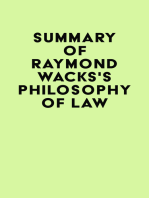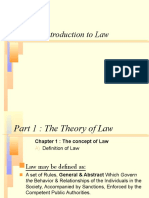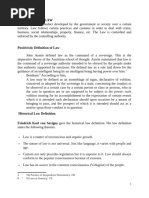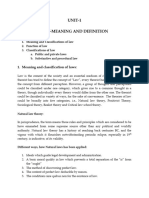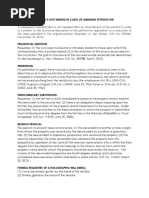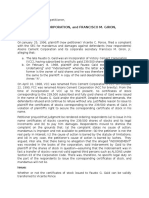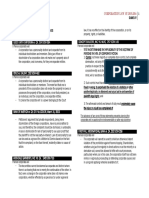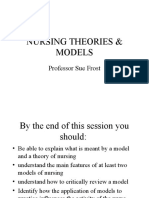Legal Philo
Legal Philo
Uploaded by
Diane UyCopyright:
Available Formats
Legal Philo
Legal Philo
Uploaded by
Diane UyOriginal Description:
Copyright
Available Formats
Share this document
Did you find this document useful?
Is this content inappropriate?
Copyright:
Available Formats
Legal Philo
Legal Philo
Uploaded by
Diane UyCopyright:
Available Formats
DEFINITION OF LAW
Much debate and perplexities arise in defining the term law. Most have limited such term to its
legal aspect, while others assert the operation of physical science thus including physical law. A simple
explanation from the former allusion however is still difficult to derive since law in the legal aspect may
be confused with statutes which are only a source of law.
Hart (1961) stated that besides the clear standard cases constituted by the legal systems of modern
states, which no one in his senses doubts are legal systems, there exist also doubtful cases, and about their
'legal quality' not only ordinary educated men but even lawyers hesitate. Hart also mentioned the salient
features of law, comprising of: (1) rules forbidding or enjoining certain types of behaviour under penalty;
(2) rules requiring people to compensate those whom they injure in certain ways; (3) rules specifying
what must be done to make wills, contracts or other arrangements which confer rights and create
obligations; (4) courts to determine what the rules are and when they have been broken, and to fix the
punishment or compensation to be paid; (5) a legislature to make new rules and abolish old ones
1
.
Thomas Rutherford on the other hand, provided for a definition of law in a general sense: any
rule of action or order of sequence from which any beings whatsoever either will not, or cannot, or
ought not to deviate.
2
A rule of action is any warrant, instruction, measure, regulation or decision governing any act,
conduct, transaction, or proceeding, including its consequences. A conspicuous example is a traffic
regulation promulgated in accordance with a city or municipal ordinance. Another obvious illustration is a
statute enacted by the legislature pursuant to its legislative powers in the constitution.
There are two important points that should be noted insofar as rules of action are concerned. First,
conduct is included in the definition. This is necessary for in the legal order there are certain conduct, e.g.
forbearance, which means intentional refraining from action, that are productive of distinct legal effects
and consequences. In other words, forbearance is fully significant as positive act. The other point is that
even though rules of action have been and are being violated they cannot be broken, in the sense that the
word is used in the vernacular. Even though rules of action are repeatedly violated or remain unobserved
they, nevertheless, continue to apply with their sanctions in full force and effect. Legally speaking,
though, rules of action may be broken for they are always subject to repeal or amendment by the body
constitutionally authorized to do so, or they may be declared null and void when they are contrary to the
constitution.
1
Hart, H. L. A. (1961). The Concept of Law. (2nd ed.). New York: Oxford University Press Inc., New York.
2
Rutherford, T., Institutes of natural law. 1. Second American Edition, New York.
NATURE OF LAW
The most prominent general feature of law at all times and places, is that its existence means that
certain kinds of human conduct are no longer optional, but in some sense obligatory. Based on such
characteristics, different forms may be inferred. The first, simplest sense in which conduct is no longer
optional, an example is when a man is forced to do what another tells him, not because he is physically
compelled, but because of fear of consequences that may arise if he refuses. A second instance in which
conduct may not be optional but obligatory is when moral rules impose obligations and withdraw certain
areas of conduct from the free option of the individual to do as he likes. These facts suggest the view that
law is best understood as a 'branch' of morality or justice and that its congruence with the principles of
morality or justice rather than its incorporation of orders and threats is of its 'essence'.
In philosophy as it relates to the nature of law, the subject deals with ideas or expression of ideas.
According to Fernandez, the expression of ideas in philosophical discourse occurs chiefly in two forms:
empirical propositions and normative propositions. The former is based on sense experience as it is used
to indicate facts. These statements correspond to events occurring and perceived in experience. In the
other kind of expression in philosophical discourse, language is used, not to communicate facts, but to
alter conduct. Normative propositions function as guides or norms of human conduct. There is a
conveyance of a command or a value judgment. The distinction between the two propositions is
conveyance of a fact, and the conveyance of a command. Legal propositions are neither a part of science
nor can they be validated by science. Rules of law are normative in character.
In line with the normative character of law, Thomas Aquinas developed the systematic treatise on
law in his work, Summa Theologica. Aquinas recognizes that it is the purpose of law to regulate
behaviour, to prescribe what must be done and to determine that in regard to which man must forbear;
hence Aquinas assails that law must be reasonable and must meet other requirements: (1) an order of
reason (2) promulgated (3) by one who has authority over the community (4) for the common good.
3
NECESSITY OF LAW
According to Lloyd, law is one of the institutions which are central to the social nature of man
and without which he would be a very different creature. To determine the necessity of law would lie on
the perception of mans nature: whether or not man is in nature evil or good. In the first perspective, that
man is by nature evil, such nature should be curbed, if not, it will lead to total destruction of man. Law
then is the indispensable restraint upon the forces of evil. Anarchy or absence of law is the supreme
horror to be warded off. While in the second perspective, man is by nature good, people who believe in
this nature of man seek to find the sources of the ills of mans present condition. The defect in mans
social environment is the true cause of the evils, which afflict him. The legal system is the source of
mans tribulations. Whether you see man as by nature evil or good, he still needs laws. 1. Mans nature is
evil thus no social progress could be attained without the restraints of penal laws. 2. Man is good but due
3
Aquino, R.C. (2006). A Philosophy of Law: an introduction to legal philosophy. Central Book Supply, Inc., Q.C.
to sin, corruption or some internal weakness, mans original and true nature had become distorted and
thus required for its control the rigors of a primitive system of laws.
LAW AND FREEDOM
Without the recognition of some authority whose decrees and sentences determine the structure of order
in the world there can be no organized society and therefore the authority of divine rule makes possible
the functioning of the universe as a social whole. But without the element of force to ensure obedience to
the divine decree the universe would never attain the role of statehood.
Authority
Some person is entitled to require the obedience regardless of whether those other persons are prepared to
find the particular order or rule upon them as acceptable or desirable or not.
Force
The force of law is and capable of being enforced by coercion.
Perspectives on the use of force to enforce law argue:
1. Force is the antithesis of law
2. Legal coercion is a matter of incidental procedure, not essential to the existence of law because people
obey the law and consent to it rather than be restrained by it.
3. International law concept of coercion is ironic because civilized countries recognize and consider
international laws as binding but is not enforceable because there are no international forces to enforce
international laws.
All levels of society human law have depended on for its ultimate efficacy on the degree to which
it is backed by organized coercion.
Freud believed that aggressive urges could be repressed but not eliminated, it seems more
probable that every culture must be built up on coercion and instinctual renunciation, hence the
connection between civilized society and coercive social order. As the use of force becomes more
regulated, it has been pushed further and further into the background. Force never was or at least has
ceased to be the essential feature in law considering the nature of man, according to Freud.
FORMS OF LAW
Since law generally arose from an idea, its expression may come in forms.
The most common is the written law. A written law refers to the law prescribed by a body having law
making power or the legislature, and is so called because the permanent memorial of it is in writing.
When a law has come in the form of a permanent written record, it has come to be called written law. The
term includes all state papers that have the force of law, treaties and constitutions as well as statutes and
city ordinances
4
.
A code is a statutory enactment which assumes to put the law of any particular subject in a complete
written form, or which assumes to embody the entire law of the jurisdiction in orderly shape. A form of
statutory law is that of the code, a textual embodiment of the law on a given subject or of all the law.
The unwritten or common law is the law declared by the judges in the decision of litigated cases which
no written law has covered and is derived from the common ideas of right and expediency. The early
English writers defined the common law as that law which had been in existence for so long that the
memory of man runneth not to the contrary. Common law is really judge made law, but only in the sense
that judges must declare and apply the fundamental ideas of justice developed by the people at large.
The judicial decisions with the opinions sustaining them are preserved in judicial reports. The courts in
deciding the cases coming before them, whether involving statutory law or common law or both,
generally in the higher courts accompany them with opinions setting forth the reasons for their decision.
The opinions constitute one of the most important sources from which the lawyer obtains his estimate of
the law.
Based on the maxim, stare decisis et non quieta novere one should follow past precedents and should
not disturb what has been settled. When the Supreme Court has once laid down a principle of law as
applicable to a certain state of facts, it will adhere to that principle and apply it to all future cases where
the facts are substantially the same. This principle assures certainty and stability in the legal system.
Supreme Court rulings are binding upon inferior courts.
4
Bayes, A.W. (n.d.) American commercial law series. Retrieved from:
http://chestofbooks.com/business/law/American-Commercial-Law-Series/Chapter-3-Form-Of-Law.
HEIRARCHY OF LAWS IN THE PHILIPPINES
The 1987 Philippine Constitution establishes limits and defines the fundamental powers of government.
It is the highest law of the land, and all other laws and legal issuances may be said to spring fromand
must be in harmony withits provisions.
National laws are those statutes enacted by the legislative authority of the Philippines. Although
legislative authority generally resides in Congress, there have been instances in history when the
executive branch exercised this power. One example is Amendment 6 of 1976, which gave full legislative
powers to then Pres. Ferdinand Marcos. As such, certain Presidential Decrees (PDs) issued by Marcos are
considered as national laws, such as PD No. 705, otherwise known as The Forestry Reform Code of the
Philippines, which is still the governing law on forestry to date.
International Treaties and Agreements, once ratified by the Senate, become part of Philippine law.
Section 21 of the 1987 Constitution provides that treaties and international agreements are valid and take
effect when concurred with by at least two-thirds of the Senate.
Executive Orders are acts of the President which provide for rules of a general or permanent character to
implement constitutional or statutory powers (De Leon, 1998)
Administrative Orders and Circulars. Administrative Orders are issuances directed to particular
offices, officials or employees for compliance on specific matters. Circulars are issuances that prescribe
policies, rules and regulations and procedures applicable to individuals and organizations outside
the government. They are designed to supplement provisions of the law or to provide means and
information for carrying out these provisions. (De Leon, 1998) An examination of AOs and circulars
issued by government agencies, however, shows that the terms order and circular are used
interchangeably.
Many of the AOs in this list cite related but older AOs as an additional reference. Some of these earlier
AOs are still effective, as they have not been expressly repealed, and may contain provisions that remain
consistent with newer AOs.
Older AOs that have been supplanted by the newer AOs are still cited because they contain definitions
that may prove useful in interpreting the newer AOs. If anything else, these repealed AOs are still helpful
in giving the reader a historical perspective of the development of policies regarding the covered subjects.
Ordinances are the legislative enactments of the respective sanggunian (council) of LGUs. The power of
LGUs to enact ordinances is based on the Local Government Code (RA 7160). Although ordinances
issued by LGUs must not contravene any law passed by Congress, such ordinances may address local
concerns that national laws fail to deal with. They are vital, as they may plug in gaps in statutes or orders,
especially related to problems particular to a province or municipality that national laws do not respond
to.
You might also like
- HLA Hart The Concept of LawDocument6 pagesHLA Hart The Concept of LawCatalin Tudoriu80% (5)
- Jurisprudence NotesDocument31 pagesJurisprudence Notessuruchiba2049No ratings yet
- Legal Systems and Methods Consolidated Notes-1 1Document103 pagesLegal Systems and Methods Consolidated Notes-1 1Super TallNo ratings yet
- Chapter 1 - Nature of Law PDFDocument9 pagesChapter 1 - Nature of Law PDFCia Lev Lim100% (1)
- What Is Law?: Salmond Definition of LawDocument5 pagesWhat Is Law?: Salmond Definition of LawHasan Muhtady100% (1)
- Legal PhilosophyDocument19 pagesLegal PhilosophyDiane UyNo ratings yet
- Legal Systems and Methods Consolidated Notes 2023Document116 pagesLegal Systems and Methods Consolidated Notes 2023angelkatao311100% (1)
- Meaning and Nature of LawDocument6 pagesMeaning and Nature of LawKamal DwivediNo ratings yet
- MEANING AND NATURE OF LAW HttpsDocument8 pagesMEANING AND NATURE OF LAW HttpsashishNo ratings yet
- Etl Chapter 1Document20 pagesEtl Chapter 1Hussen RediNo ratings yet
- Bishop Stuart University Name: Faculty: Law Course:: Nuwagira AllanDocument10 pagesBishop Stuart University Name: Faculty: Law Course:: Nuwagira Allanmujuni brianmjuNo ratings yet
- The Relationship Between Law and MoralityDocument14 pagesThe Relationship Between Law and MoralityCocobutter VivNo ratings yet
- Business Law From Acc Department.Document83 pagesBusiness Law From Acc Department.newaybeyene5No ratings yet
- Unit One Business LawDocument21 pagesUnit One Business LawElias ShiferawNo ratings yet
- Introduction To Law, Morrocan CaseDocument38 pagesIntroduction To Law, Morrocan CaseOussama RaourahiNo ratings yet
- SFL Module 1 Notes PDFDocument55 pagesSFL Module 1 Notes PDFMidgardianNo ratings yet
- Business Law Teaching MaterialDocument77 pagesBusiness Law Teaching MaterialteddyNo ratings yet
- Law and MoralityDocument5 pagesLaw and MoralityAkinsola HammadNo ratings yet
- Interpretation of StatuteDocument84 pagesInterpretation of StatuteElsa ShaikhNo ratings yet
- Intro To Law 1Document6 pagesIntro To Law 1yssahmariebongabong100% (1)
- LAW-ENGINEERS FINALDocument118 pagesLAW-ENGINEERS FINALbrendamulureNo ratings yet
- Introdcution To LawDocument10 pagesIntrodcution To LawramilflecoNo ratings yet
- Business LawDocument63 pagesBusiness Lawnatiman090909No ratings yet
- Legal method (Prof. Edeko)Document11 pagesLegal method (Prof. Edeko)annablla360No ratings yet
- LE 151 GenPrinLaw - LectureNotes 2Document32 pagesLE 151 GenPrinLaw - LectureNotes 2equarhadeparhzahraNo ratings yet
- Notes 1Document9 pagesNotes 1brendamulureNo ratings yet
- Juris ProjectDocument23 pagesJuris ProjectJebin JamesNo ratings yet
- LM Notes PrakharDocument27 pagesLM Notes Prakharshreyan.chaudhary24No ratings yet
- Business Law Hand outDocument78 pagesBusiness Law Hand outmihretayalew96No ratings yet
- Introduction To Law PDFDocument24 pagesIntroduction To Law PDFKenny JNo ratings yet
- Analytic and Normative Juris (Group 19)Document34 pagesAnalytic and Normative Juris (Group 19)Leiya LansangNo ratings yet
- Introduction To Law Session One - HANDOUT 1.2Document11 pagesIntroduction To Law Session One - HANDOUT 1.2Getahun AbebawNo ratings yet
- 1) Jurisprudence: MeaningDocument71 pages1) Jurisprudence: Meaninganilasuman1975No ratings yet
- IURI 171 OpsommingsDocument5 pagesIURI 171 OpsommingsamoneNo ratings yet
- Interpretation of StatuteDocument79 pagesInterpretation of StatuteElsa ShaikhNo ratings yet
- K C I W P: EY Oncepts Ndian AND Estern ErspectivesDocument8 pagesK C I W P: EY Oncepts Ndian AND Estern ErspectivesVenugopal ThiruvengadamNo ratings yet
- Natural Law - An ExaminationDocument5 pagesNatural Law - An ExaminationIsabella HannahNo ratings yet
- LAW NatureDocument17 pagesLAW Natureshreyasanand1122No ratings yet
- Mercy What Is LawDocument6 pagesMercy What Is LawMercy NamboNo ratings yet
- New Legal Methods NotesDocument18 pagesNew Legal Methods NotesShazadi SadaquthNo ratings yet
- The Concept of Law and JusticeDocument5 pagesThe Concept of Law and JusticeYash SinghNo ratings yet
- What Is Law PPT and Philosophy of LawpptxDocument178 pagesWhat Is Law PPT and Philosophy of LawpptxdenyohsylvesterNo ratings yet
- Philosophy of Law Group 6Document7 pagesPhilosophy of Law Group 6JENNIFER BERYLL BIDANGNo ratings yet
- Jurisprudence Law and Legal TheoryDocument10 pagesJurisprudence Law and Legal TheoryAble- Don FooteNo ratings yet
- Juris AnswersDocument12 pagesJuris Answersajit singhNo ratings yet
- Legal PositivismDocument2 pagesLegal Positivismhudhudfiz gamingNo ratings yet
- Introduction to English JurisprudenceDocument4 pagesIntroduction to English Jurisprudencehudhudfiz gamingNo ratings yet
- Natural LawDocument6 pagesNatural LawWaqqar Un NisaNo ratings yet
- 8 RavindraDocument13 pages8 RavindraRudejane TanNo ratings yet
- Philosophy 1Document10 pagesPhilosophy 1ashusworld75No ratings yet
- Philo Intro LectureDocument27 pagesPhilo Intro LectureGlen Darren LongjasNo ratings yet
- Bussiness Law - Chapter OneDocument9 pagesBussiness Law - Chapter OneN ENo ratings yet
- Legal Method Unit 1Document16 pagesLegal Method Unit 1Yuvam GargNo ratings yet
- AAA Conceptual Theories of LawDocument7 pagesAAA Conceptual Theories of LawDian GonzalesNo ratings yet
- Philosophy of Law 2023Document116 pagesPhilosophy of Law 2023Syeda Imama100% (1)
- Functions of LawDocument9 pagesFunctions of Lawsaqibshahbaz586No ratings yet
- Topic1 Business & Corporate LawDocument14 pagesTopic1 Business & Corporate LawLearnmore ChikukwaNo ratings yet
- Criticism On Law and MoralityDocument4 pagesCriticism On Law and MoralityMahmudul HasanNo ratings yet
- Criminal Law Case DigestsDocument10 pagesCriminal Law Case DigestsDiane UyNo ratings yet
- Comm LMTDocument5 pagesComm LMTDiane UyNo ratings yet
- When Republication Is Not Needed in Cases of Amended Petition For RegistrationDocument3 pagesWhen Republication Is Not Needed in Cases of Amended Petition For RegistrationDiane UyNo ratings yet
- Juno Batistis vs. People of The Philippines, G.R. No. 181571 December 16, 2009Document2 pagesJuno Batistis vs. People of The Philippines, G.R. No. 181571 December 16, 2009Diane UyNo ratings yet
- Tax Doctrines in Dimaampao CasesDocument3 pagesTax Doctrines in Dimaampao CasesDiane UyNo ratings yet
- TAX CASE MV Don Martin vs. Secretary of FinanceDocument1 pageTAX CASE MV Don Martin vs. Secretary of FinanceDiane UyNo ratings yet
- Commercial Law FaqsDocument30 pagesCommercial Law FaqsDiane UyNo ratings yet
- Comsavings Bank (Now Gsis Family Bank) vs. Spouses Danilo and Estrella Capistrano G.R. No. 170942 August 28, 2013Document2 pagesComsavings Bank (Now Gsis Family Bank) vs. Spouses Danilo and Estrella Capistrano G.R. No. 170942 August 28, 2013Diane UyNo ratings yet
- Stronghold Insurance CompanyDocument2 pagesStronghold Insurance CompanyDiane UyNo ratings yet
- Halley vs. Printwell: DoctrineDocument2 pagesHalley vs. Printwell: DoctrineDiane UyNo ratings yet
- Korean Technologies v. LermaDocument2 pagesKorean Technologies v. LermaDiane UyNo ratings yet
- V. Loyola Grand VillasDocument2 pagesV. Loyola Grand VillasDiane UyNo ratings yet
- Ferdinand Cruz vs. Alberto Mina GR No. 154207 April 27, 2007 FactsDocument5 pagesFerdinand Cruz vs. Alberto Mina GR No. 154207 April 27, 2007 FactsDiane UyNo ratings yet
- Ponce Vs Alsons CementDocument3 pagesPonce Vs Alsons CementDiane UyNo ratings yet
- Sobrejuanite Vs AsbDocument3 pagesSobrejuanite Vs AsbDiane Uy100% (1)
- Christmas Game 2016Document8 pagesChristmas Game 2016Diane UyNo ratings yet
- New Frontier SugarDocument3 pagesNew Frontier SugarDiane UyNo ratings yet
- Pale Privileged CommunicationDocument9 pagesPale Privileged CommunicationDiane UyNo ratings yet
- TAX CASES Assignment 1Document26 pagesTAX CASES Assignment 1Diane UyNo ratings yet
- Pale Privileged CommunicationDocument9 pagesPale Privileged CommunicationDiane UyNo ratings yet
- Corporation Law 1st BatchDocument15 pagesCorporation Law 1st BatchDiane UyNo ratings yet
- Common People PulpDocument4 pagesCommon People PulpJovana0% (1)
- Designers Guide To EN1992-2 Eurocode 2Document23 pagesDesigners Guide To EN1992-2 Eurocode 2Cheolung Yoon33% (3)
- SI 4121 Pengantar Dinamika Tanah Dan Rekayasa Gempa#4 Modeling Soil Response During Shear CyclesDocument84 pagesSI 4121 Pengantar Dinamika Tanah Dan Rekayasa Gempa#4 Modeling Soil Response During Shear CyclesChristopher GilbertNo ratings yet
- Supply Chain Management Practices and Problems in A Cement Company, Philippines: Basis For An Automated System DesignDocument5 pagesSupply Chain Management Practices and Problems in A Cement Company, Philippines: Basis For An Automated System DesignarjayNo ratings yet
- The Villages and Ujamaa Villages (Registration, Designation SWDocument9 pagesThe Villages and Ujamaa Villages (Registration, Designation SWbukamakidunda27No ratings yet
- Background and History of LICDocument82 pagesBackground and History of LICVittalrao Kilikile100% (1)
- Article IBM-Lenovo MergerDocument28 pagesArticle IBM-Lenovo MergerPrankitNo ratings yet
- Emfss Prospectus 2018 19Document50 pagesEmfss Prospectus 2018 19arcanum78No ratings yet
- Research Paper For Publication - Docx DR - Azra IshratDocument16 pagesResearch Paper For Publication - Docx DR - Azra IshratAzra IshratNo ratings yet
- Ujian Pentaksiran Setara Standard 2021Document65 pagesUjian Pentaksiran Setara Standard 2021NUR ADLIANA JUITA BINTI ADLI AMINUDDIN KPM-GuruNo ratings yet
- HandoutDocument8 pagesHandoutaxelgiovanniNo ratings yet
- 12-Comprehensive Components MonitoringDocument39 pages12-Comprehensive Components Monitoringtalyerautoshop5432No ratings yet
- What Is TeachingDocument26 pagesWhat Is TeachingGiezyle MantuhanNo ratings yet
- Contoh Soal Bahasa Inggris Sekolah Dasar (SD)Document3 pagesContoh Soal Bahasa Inggris Sekolah Dasar (SD)nuraeni1216No ratings yet
- раздел 3Document19 pagesраздел 3Ярослава АлександроваNo ratings yet
- P2 Holiday Pack 2024 Term 3 (1)Document40 pagesP2 Holiday Pack 2024 Term 3 (1)GLOBAL CAFENo ratings yet
- Indian Partnership Act Notes by JK Shah ClassesDocument45 pagesIndian Partnership Act Notes by JK Shah Classeskanchan100% (1)
- Adobe Scan 22 Dec 2020 PDFDocument4 pagesAdobe Scan 22 Dec 2020 PDFtest2k3No ratings yet
- Nursing Theories & Models: Professor Sue FrostDocument28 pagesNursing Theories & Models: Professor Sue FrostsuthaNo ratings yet
- Group 2 Parental InvolvementDocument28 pagesGroup 2 Parental InvolvementDainielle BianzonNo ratings yet
- GeroDocument7 pagesGeroJehanie LukmanNo ratings yet
- Psychological Perspective of The Self: Person. Having Its Own or Single Character As A PersonDocument5 pagesPsychological Perspective of The Self: Person. Having Its Own or Single Character As A PersonJanderick DeveraNo ratings yet
- Seance 1 The West Wind Cours Eleves Mercredi Et SamediDocument10 pagesSeance 1 The West Wind Cours Eleves Mercredi Et SamediÉloi mertzNo ratings yet
- IN THE MARGINS BEHIND THE LINES Collected Writings Volume IIDocument3 pagesIN THE MARGINS BEHIND THE LINES Collected Writings Volume IIsiegelsupportNo ratings yet
- Comparative Investigations of Organic CompoundsDocument3 pagesComparative Investigations of Organic CompoundsEden SagaNo ratings yet
- BPT LessonDocument3 pagesBPT Lessonapi-688108430No ratings yet
- CCNP R&S SWITCH 300-115 Foundation Learning Guide-130-208Document79 pagesCCNP R&S SWITCH 300-115 Foundation Learning Guide-130-208eduar marinNo ratings yet
- Jrotc Syllabus Sy22-23 2Document5 pagesJrotc Syllabus Sy22-23 2api-201178565No ratings yet
- Hodder Checkpoint SpreadDocument18 pagesHodder Checkpoint SpreadDewa Sudiatmika100% (1)
- 6 Steps From Customer ServiceDocument3 pages6 Steps From Customer ServiceSaranya SaranNo ratings yet



